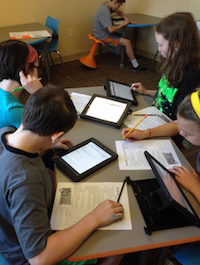 With more and more classrooms having access to technology, teachers are on the lookout for ways to use the technology in meaningful ways. As it has been said, if it can’t be done better with technology, then don’t use technology. So how do we know if technology does something better? Sometimes you have to try something out to know for sure. In my classroom, I used student blogs to replace our literature response journals using kidblog.com (though the blogging platform doesn’t make a difference). Below are five reasons I found that blogging did in fact make literature response journals better.
With more and more classrooms having access to technology, teachers are on the lookout for ways to use the technology in meaningful ways. As it has been said, if it can’t be done better with technology, then don’t use technology. So how do we know if technology does something better? Sometimes you have to try something out to know for sure. In my classroom, I used student blogs to replace our literature response journals using kidblog.com (though the blogging platform doesn’t make a difference). Below are five reasons I found that blogging did in fact make literature response journals better.
Students have a wider audience. When students write in a journal and turn it in the to the teacher, they are writing for an audience of one. While there is much to be gained from these types of journals, it isn’t what most would call an authentic audience. When blogging, students have the opportunity to write for a much wider audience. Even with Kidblog (which exists behind a password-protected wall) the students can read and respond to each other’s work. Here is how one of my students put it: “I got to share with people my age and got to see what they shared with the group. I really think that that made me go deeper, because seeing what they were thinking let me see different ways to think about things.”
Students love them. As teachers, we know that student engagement is a huge component of student learning. We also know that, often, engagement is bought at the price of depth or longevity. Sure, games and apps are fun, but often they leave out important information students need to know; and we have all experienced the “engagement high” of a new piece of technology that soon wears off after the “newness” is gone. But with blogging the literature response journals, it is not about the new flashy tablet or the bells and whistles of a game. Instead it’s about doing real work in a new way while simultaneously encouraging kids to read and critique each other’s work. This adds a dimension to their learning that is missing with more traditional, paper-based journals. After an eight-week trial run, I used an anonymous survey to find out what my students thought. Overwhelmingly they said they enjoyed the blogs and 100% of them voted to continue using them as opposed to going back to the more traditional journals.
They enhance digital literacy. One of the most popular catchphrases when talking about students in school today is “digital natives”. This term was coined by Marc Prensky to describe how students in today’s schools think differently than students before the digital revolution. While Prensky was really talking about how the brain is wired, many teachers think this means that students are innately able to navigate digital spaces and understand what is going on intuitively. Far from it! Students need even more guidance in the digital world than they did previously. Just because they know how to figure out how to play a game doesn’t mean they know how to use digital tools to create, edit, and critique content. Digital literacy is much more than being willing to point and click. As Howard Reingold has written:
This population is both self-guided and in need of guidance, and although a willingness to learn new media by point-and-click exploration might come naturally to today’s student cohort, there’s nothing innate about knowing how to apply their skills, (2006).
Using student blogs is a perfect way to guide students in the application of digital skills and their intersection with good writing.
The first three items centered on the student-and rightly so. But the reality of anything in the classroom is that it is going to affect the teacher. There are many ideals that are not actually doable in a classroom situation, making their implementation impossible or at least improbable. So, how does using student blogs help you as a teacher?
You can provide more and better feedback. It is a well-established fact that students need feedback in order to improve their writing. As Marzano, Pickering, and Pollock (2001) assert, feedback must be timely and specific in order to have the biggest impact on student performance. Unfortunately, providing feedback is often one of the hardest parts of the job. However, having access to student work online allows such feedback to be given more regularly, giving it the best chance to really change student thinking and understanding. Having all that work online also leads me to reason number five”
They are easier to grade. Anyone who has taught has experienced the long walk to the parking lot loaded down by a bag full of student work to be graded. This load is increased when student journals are included. You are lugging an entire journal home to grade one and a half pages of writing. On top of that, you dread the writer’s cramp that will surely occur in the midst of commenting on 20+ student journals. Having their work online eliminates this hassle. While you still have to read and respond to 20+ journals, all you need is a device that can connect to the Internet. Whether using a desktop, laptop, or even a mobile device, you have complete access to your students’ work whenever and wherever you are without having to take their journals with you. Many teachers type faster than they can write by hand, which also increases your speed giving you the opportunity to say a little more. And even better, if you have a mobile device with voice-to-text features, you can just dictate your feedback-provided your device can understand you!While this last point may seem trivial, any time you can add efficiency to grading student assignments you are making an impact on practice.
So there you have my top five reasons to try student blogging for literature response journals. Have you had experience with student blogging? What are your favorite benefits?References:Marzano, R. J., Pickering, D. J., & Pollock, J. E. (2001). Classroom Instruction that Works: Research-Based Strategies for Increasing Student Achievement. Alexandria, VA: ASCD.Prensky, M. (2001). “Digital Natives, Digital Immigrants”. Retrieved June 27, 2014, from marcprensky.com/writing/Prensky%20-%20Digital%20Natives,%20Digital%20Immigrants%20-%20Part1.pdfReingold, H. (2006). Howard Reingold, “Second life: Symposium on Impact of Digital Learning.” (Podcast) Retrieved February 13, 2009 from nmc.org/podcast/pedagogy-civic-participation
